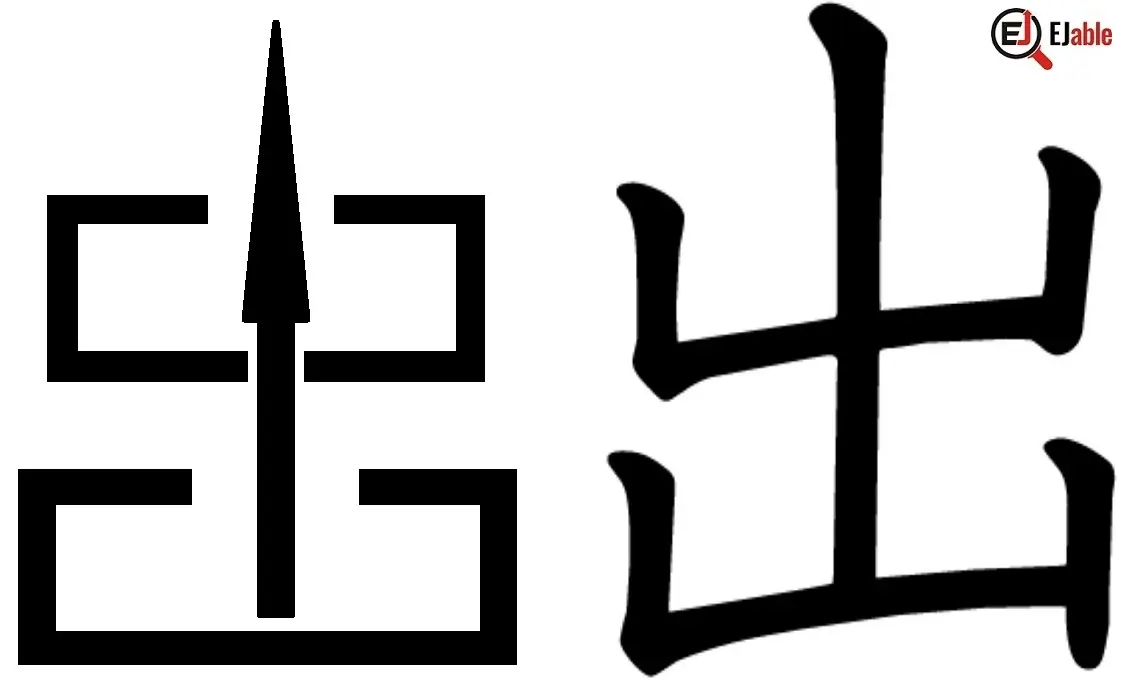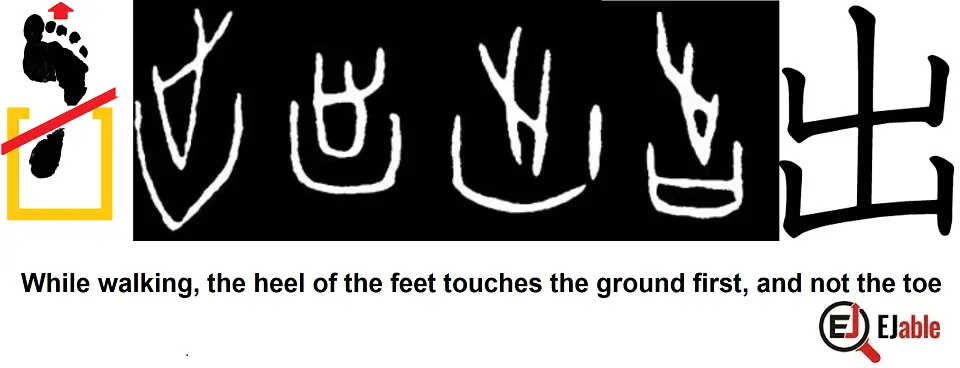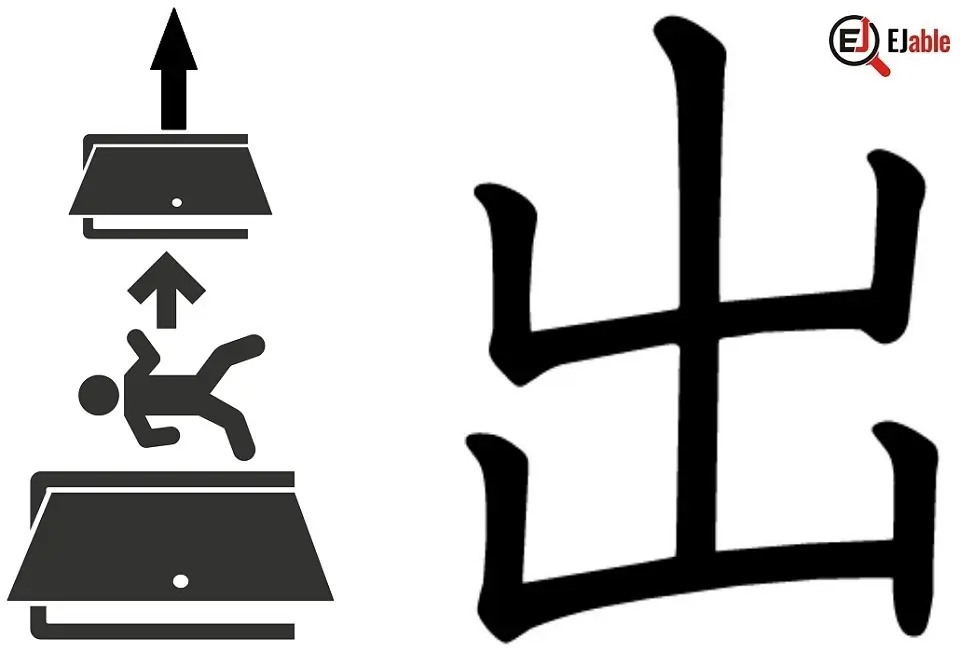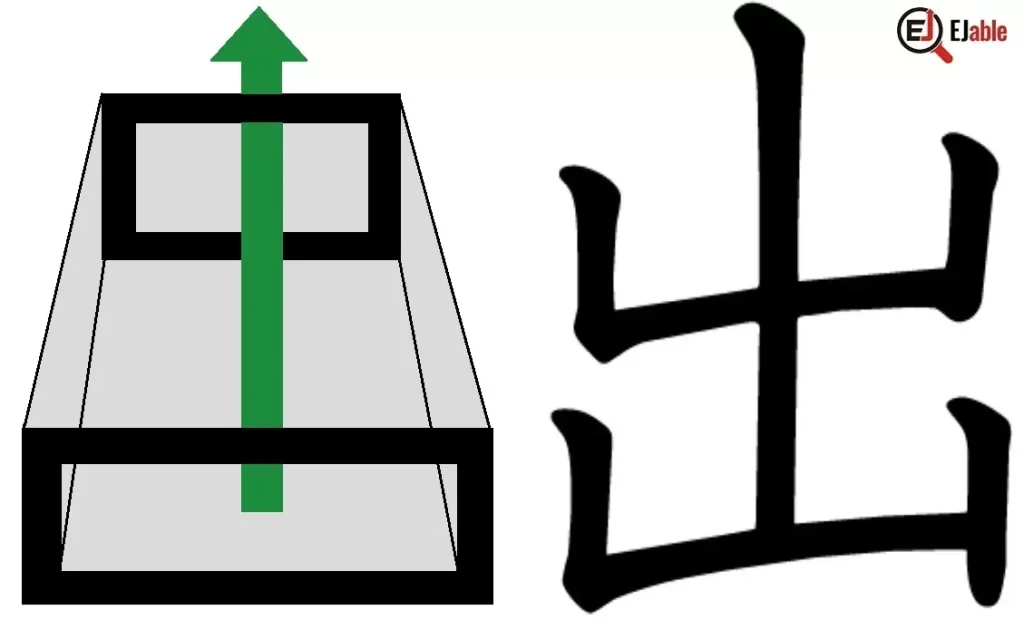Kanji for “Going Out” or “To Exit”: 出

The Japanese kanji for “going out” (to go out), “to leave,” “to exit”, or “to pull out” is 出. This kanji is pronounced “De” (as in “de-ru”), Da (as in “da-su”) in its kun’yomi reading, and “shutsu” or “sui” in its on’yomi reading.
The Kanji 出 is constructed with 5 strokes, and it is part of the JLPT N5 syllabus (please check the list of JLPT N5 Kanji). In Japanese schools, this Kanji is taught in grade 1.
This article will discuss the origin of the Kanji “to go out” and easy ways to remember it. We will also discuss the radicals of this Kanji and the compounded words in which it appears.
Other Meanings of 出
The versatility of 出 extends far beyond its primary meaning. In Japanese, it is used in contexts like “sunrise” (日の出) — where the sun ‘comes out’, and “publication” (出版) — where a book ‘comes out’ to the public. And “appearance” (出演) — where a performer ‘comes out’ on stage.
Some of the main contexts for which kanji 出 appears are as follows:
- Leave
- depart
- Emit
- produce
- Publish
- Surface,
- Come forth
- Rise (e.g., the sun)
- Amount or number of (when used as a counter)
- Start or begin
Origin of the Kanji 出

The origin of the kanji 出 dates back to ancient Chinese pictographs. The original shape of the Kanji depicted a foot stepping forward, leaving the impression of the heel on the ground.
This Kanji resembles the Kanji for Mountain and makes an impression that it is a combination of one mountain over another mountain. However, please note that the Kanji to “go out” (出) has no relation with the Kanji of the mountain.
How to Remember the Kanji 出 (To Exit or to Go Out)
Over the millennia, the shape of the Kanji “to exit” underwent simplification, leading to its present form.
The vast amount of simplification makes the Kanji 出 among those Kanji characters where the origin does not help in memorizing the shape. However, while the essence of a foot moving isn’t immediately obvious in the modern character, knowing this background allows for a deeper appreciation of the character’s design.
To help memorize this Kanji, we present the following two visualizations as mnemonics.
Mnemonic 1:

Explanation:
Let’s imagine a person coming out of the door of one room of the house to the outer room and then exiting the front door to go outside.
In the above picture, consider the bottom shape as the door of the inner room, with the vertical line as an arrow to represent the direction of movement. A similar “open box” shape at the top can be considered as the house’s front door, which leads you outside.
Consider the continuing vertical line as the arrow representing the person moving out of the house.
Mnemonic 2:

Explanation of Mnemonic 2
The above visualization is self-explanatory. Consider the bottom and top “open box” shapes as the two sides of a box, with the vertical line as an arrow indicating an exit from the box.
Cultural Significance
In Japanese culture, the idea of “going out” or “emerging” can have various connotations, from the literal act of leaving a place to the metaphorical sense of beginning a new phase in life. Phrases like “出る杭は打たれる” (The stake that sticks up gets hammered down) use the kanji 出 to convey societal norms and expectations.
Kanji 出 as a Component
In the context of Kanji composition, 出 (shutsu), meaning “exit” or “emerge,” is not typically used as a radical in other Kanji characters. Instead, it commonly appears as a component that combines with other radicals to form various Kanji. As a component, 出 contributes to the overall meaning of the character, often adding a sense related to emerging, going out, or producing something.
There are 26 Kanji characters using 出 as a component. Out of these, the following 5 are the Jōyō Kanji:
- 掘 (ほる): This kanji means “to dig” and is used in words like 発掘 (はっくつ), meaning “excavation” or “discovery”.
- 堀 (ほり):L Meaning “moat” or “ditch”, it’s a less common character but still recognized and used in certain contexts, especially in place names or surnames.
- 窟 (くつ): This kanji for “cave” or “den” is less common in daily usage but can be found in specific contexts, like in words related to caves or geological studies.
- 拙 (せつ or つたない): This kanji means “unskillful” or “clumsy”. The word 拙者 (せっしゃ) is an old-fashioned first-person pronoun, and 拙速 (せっそく) means “slow” or “dull”.
- 屈 (くつ): This kanji, meaning “to bend” or “yield”, is used in words like 屈辱 (くつじょく), meaning “humiliation” or 屈折 (くっせつ) meaning “refraction”.
All these kanji are part of the Japanese writing system and can be found in dictionaries, literature, and other written materials. However, their frequency of usage can vary, with some being more common and others less so.
Compound Words (Kanji) Using 出
The Kanji 出 very frequently appears in kanjis of compounded Japanese words. Here are some compounded words that use the kanji 出 for “go out” or “exit”:
- 出入り (でいり) – Coming and going; traffic (of people).
- 出発 (しゅっぱつ) – Departure.
- 出演 (しゅつえん) – Performance; stage appearance.
- 出産 (しゅっさん) – Childbirth; birth.
- 出版 (しゅっぱん) – Publication.
- 出勤 (しゅっきん) – Going to work; attendance.
- 出費 (しゅっぴ) – Expenditure; expenses.
- 出口 (でぐち) – Exit (like in a building or train station).
- 出場 (しゅつじょう) – Appearance; participation (in an event).
- 出身 (しゅっしん) – Origin; birthplace.
- 出張 (しゅっちょう) – Official tour; business trip.
- 出会い (であい) – Meeting; encounter.
- 出血 (しゅっけつ) – Bleeding; hemorrhage.
- 出席 (しゅっせき) – Attendance.
- 出題 (しゅつだい) – Setting questions; proposing a problem.
These are just a few examples of words containing the kanji 出. The character is extremely versatile in its applications, given the broad concept it represents.
Check other Kanji characters on the page “How to Learn Kanji“.

A long-term ex-pat in Japan, Himanshu comes with an IT background in SAP consulting, IT Business Development, and then running the country operations of an IT consulting multinational. Himanshu is the co-founder and Managing Director of ReachExt K.K. and EJable.com. He is also an Advisory Board Member of a Silicon Valley AI/IoT startup.
